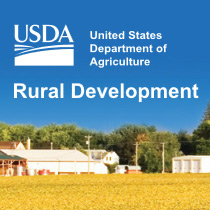
WASHINGTON – USDA is making up to $10 million available to help people living in rural towns develop community renewable energy projects that will help them cut their energy costs and contribute to the nationwide effort to reduce pollution that contributes to climate change. These funds will be targeted to help people who live in communities that have been historically underinvested and disinvested.
USDA is making the funds available through the new Rural Energy Pilot Program to help the people of rural America build back better, stronger, and more equitably than ever before. Through this program, USDA is supporting the Biden-Harris Administration’s commitment to making environmental justice a part of every agency’s mission to address the disproportionate health, environmental, economic, and climate impacts on disadvantaged communities.

“Under the leadership of President Biden and Vice President Harris, USDA is providing grant assistance for people who live in particularly underserved rural towns to help them cut their household energy costs and address climate change at the local level,” Vilsack said. “As we continue to rebuild the nation’s infrastructure, USDA is targeting resources and investments to help meet our nation’s energy needs and combat climate change. The new program we’re announcing today will pilot the viability of community-scale renewable energy investments to mitigate the energy-burdened circumstances of particularly disadvantaged rural communities. This assistance will help to keep people in their hometowns by supporting good-paying jobs, business opportunities, and a more affordable cost of living.”
Background:
USDA will make up to $10 million in grants available to particularly underserved rural communities. The funds can be used to deploy community-scale renewable energy technologies and innovations to reduce climate pollution and increase resilience to the impacts of climate change. These technologies include solar, wind, geothermal, micro-hydroelectric, and biomass/bioenergy. Up to 20% of awarded funds may also be used for community energy planning, capacity building, technical assistance, energy efficiency, and weatherization.
USDA is offering priority points to projects that advance key priorities under the Biden-Harris Administration to help communities recover from the COVID-19 pandemic, advance equity, and combat climate change. These extra points will increase the likelihood of funding for projects seeking to address these critical challenges in rural America.
Details on an upcoming informational webinar is forthcoming and will be posted to the Rural Energy Pilot Program webpage.
Prospective applicants must inform the Agency by submitting a required Letter of Intent prior to submission of a complete application. The letters must be submitted via electronic upload into a secure cloud vault, by 11:59 p.m. EST on April 19, 2022.
Application guides and submission information are available on the program website, under the To Apply tab, www.rd.usda.gov/programs-services/energy-programs/rural-energy-pilot-program.
For additional information, see page 2747 of the Jan. 19 Federal Register (PDF, 278 KB).
Under the Biden-Harris Administration, Rural Development provides loans and grants to help expand economic opportunities, create jobs, and improve the quality of life for millions of Americans in rural areas. This assistance supports infrastructure improvements; business development; housing; community facilities such as schools, public safety, and health care; and high-speed internet access in rural, tribal, and high-poverty areas. For more information, visit www.rd.usda.gov. If you’d like to subscribe to USDA Rural Development updates, visit our GovDelivery subscriber page.
USDA touches the lives of all Americans each day in so many positive ways. Under the Biden-Harris Administration, USDA is transforming America’s food system with a greater focus on more resilient local and regional food production, fairer markets for all producers, ensuring access to safe, healthy, and nutritious food in all communities, building new markets and streams of income for farmers and producers using climate-smart food and forestry practices, making historic investments in infrastructure and clean energy capabilities in rural America, and committing to equity across the Department by removing systemic barriers and building a workforce more representative of America. To learn more, visit www.usda.gov.



